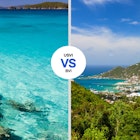
Dec 22, 2025 • 10 min read
Tucked between the Sahara and the Med, Tunisia packs a lot of wonders into its compact territory. Here's everything you need to know about getting around.

Dec 22, 2025 • 10 min read
Tucked between the Sahara and the Med, Tunisia packs a lot of wonders into its compact territory. Here's everything you need to know about getting around.

Dec 22, 2025 • 11 min read
Plan your family travels in Japan with this guide to the best experiences that kids will love.

Dec 22, 2025 • 6 min read
This gem in the Florida Keys offers a winning mix of nature, culture and rum cocktails. These are the best things to do in Islamorada.

Dec 22, 2025 • 7 min read
Cairo, the original city that never sleeps, is at the epicenter of the action in Egypt. Here are the best things to do there.

Dec 22, 2025 • 5 min read
Exhibitions at US museums in 2026 will highlight Impressionist works, showcase Renaissance masters and celebrate American art.

Dec 22, 2025 • 13 min read
Uzbekistan's stunning architecture and lively bazaars are a traveler’s dream. This weeklong itinerary shows off the best of the Central Asian showstopper.

Dec 22, 2025 • 5 min read
From sampling wine from cellar doors to hiking through national parks, here are the top things to do in southeast Queensland’s stunning Scenic Rim.

Dec 22, 2025 • 5 min read
A trio of tiny Indonesian islands are just a ferry ride from Bali, and they're fringed by dreamy white sand beaches. Here's how to pick your best one.

Dec 21, 2025 • 8 min read
The continent is teeming with surprises once you dip below the surface.

Dec 21, 2025 • 7 min read
Our travel writers can help you choose between the US Virgin Islands (USVI) and the British Virgin Islands (BVI) for your Caribbean vacation.

Dec 21, 2025 • 9 min read
Where should you go to celebrate one of the world's greatest festivals? Here's our guide to the best Carnival celebrations.

Dec 20, 2025 • 8 min read
From educational museums to challenging hikes to leisurely cycling, here are the top free ways to enjoy your trip to Phoenix.

Dec 19, 2025 • 2 min read
At Volcano House, tuck into a comfortable seat with a cocktail and a magical, memorable view of the Kīlauea volcano at Hawai‘i Volcanoes National Park.

Dec 19, 2025 • 7 min read
Cuba has a range of accommodations, from simple private homestays to luxurious all-inclusive resorts. Here’s all you need to know.

Dec 19, 2025 • 6 min read
Whether you call it chai, cha, chaha, choi or sah, tea is a necessity in most of India. Here's what you need to know.

Dec 19, 2025 • 14 min read
Magical doesn’t come close to describing the wonder that lit up the sky all night long on a 5-day dream trip to see the northern lights in Fairbanks, Alaska.

Dec 19, 2025 • 9 min read
Seattle can be an expensive city to visit, but we've rounded up top attractions that won't cost you a dime.

Dec 19, 2025 • 6 min read
St Lucia has a well-earned reputation as a blissfully tranquil place to visit. Make it even easier with local tips on the climate, costs and customs.

Dec 19, 2025 • 9 min read
These are the most exciting train routes for 2026.

Dec 19, 2025 • 11 min read
Where do you begin to explore the storied, sprawling city of İstanbul? Start with these 16 top experiences.

Dec 19, 2025 • 6 min read
Latin American and the Caribbean are where Carnivals truly come alive. Find the perfect celebration for you with this ultimate guide.

Dec 18, 2025 • 9 min read
Low-key Bonaire is known for its world-class diving but offers far more than underwater adventures. Here are some of the best things to do in Bonaire.